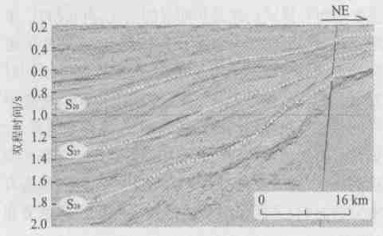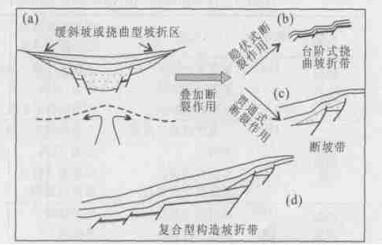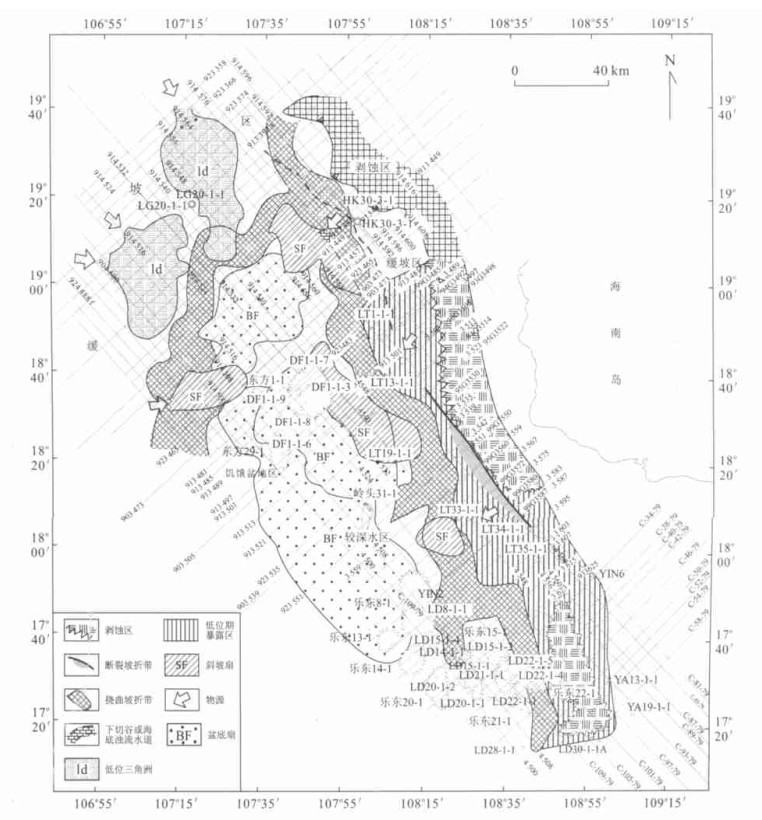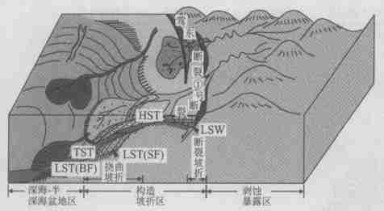Patterns of Slope-Break Zone and Their Depositional Models in the Yinggehai Basin
-
摘要: 坡折带是层序样式划分的重要依据.大量地震剖面的精细解剖表明, 莺歌海盆地坡折带可划分为构造坡折带和沉积坡折带, 进而将层序构成样式划分为四类, 即挠曲坡折型、断裂坡折型(生长断裂型)、沉积坡折型(陆架陆坡型, 相当于Ⅰ类层序)和缓坡型.不同类型层序样式控制不同低位体的空间分布.挠曲坡折、断裂坡折和沉积坡折控制了各三级层序中斜坡扇和盆底扇的分布, 而缓坡控制强制性海退型低位三角洲的分布.详细的构造研究表明, 莺歌海盆地裂后期边缘断裂, 如①号断裂和莺东断裂在不同时期不同部位仍表现出程度不同的活动性.正是由于这些断层的活动性及其在空间上的差异性, 控制了盆地内坡折带的发育.Abstract: The slope-break is thought to be an important criterion to distinguish the patterns of sequences. In the Yinggehai basin, the slope-break can be classified into two types: structural and sedimentary slope-break zones, which can be divided further into four patterns, that are bend slope-break, fault slope-break(growing fault), sedimentary slope-break(shelf/slope-break)and gentle slope types. Different patterns of sequences control different distributions of lowstand sandstones. The bend slope-break, fault slope-break and sedimentary slope-break restrict the distribution of slope fans and basin floor fans in the third-order sequences, and the gentle slope-break limits the distribution of lowstand deltas which were formed in the course of restricted sea-level decrease. The results of tectonic researches show that the marginal faults, such as the No.1 fault and the Yingdong fault, still are active during the post-rifting stage, which controlled the formation of slope-break in this basin.
-
Key words:
- pattern of slope-break /
- depositional model /
- Yinggehai basin
-
表 1 4种层序样式的沉积体系及其配置样式
Table 1. Depositional pattern and distribution in four kinds of sequences in Yinggehai basin

-
Cross, T. A., 1994. High-resolution stratigraphic correlation from the perspective of base-level cycles and sediment accommodation. Proceedings of northwestern European sequence stratigraphy congress, 105-123. Galloway, W.E., 1988. Genetic stratigraphic sequences in basin analysis, Ⅱ : Application to Northwest Gulf of Mexico Cenozoic basin. AAPG Bulletin, 73: 143-154. Gong, Z.S., Li, S.T., Xie, T.J., 1997. Distribution of continental margin basins and hydrocarbon accumulation in the northern of South China Sea. Science Press, Beijing(in Chinese). Hu, Z.Q., Zhu, X.M., 2002. Sequence stratigraphic simulation of depression lake basin with topographic ramp. Acta Sedimentologic Sinica, 20(2): 217-221(in Chinese with English abstract). Li, S.T., Pan, Y.L., Lu, Y.C., et al., 2002. Key technology of prospecting and exploration of subtle traps in lacustrine fault basins: Sequence stratigraphic researches on the basis of high resolution seismic survey. Earth Science— Journal of China University of Geosciences, 27(5): 592-598(in Chinese with English abstract). Li, S.T., Wang, H., Lu, F.X., et al., 1999. Basin geodynamics-fundamental idea and some approaches. China University of Geosciences Press, Wuhan(in Chinese). Lin, C.S., Pan, Y.L., Xiao, J.X., et al., 2000. Structural slope-break zone: Key concept for stratigraphic sequence analysis and petroleum forecasting in fault subsidence basins. Earth Science— Journal of China University of Geosciences, 25(3): 260-266(in Chinese with English abstract). Mitchum, R.M., Wagoner, V.J.C., 1991. High-frequency sequences and their stacking patterns: Sequence stratigraphic evidence of high-frequency eustatic cycles. Sediment Geol., 70: 131-160. doi: 10.1016/0037-0738(91)90139-5 Morley, C.K., 2001. Combined escape tectonics and subduction rollback-back arc extension: A model for the evolution of Tertiary rift basins in Thailand, Malaysia and Laos. Journal of the Geological Society, 158: 461-474. doi: 10.1144/jgs.158.3.461 Posameentier, H.W., 1992. Forced regressions in a sequence stratigraphic framework: Concepts, examples, and exploration significance. AAPG, 76(7): 1687-1709. Wagoner, V.J.C., Posamentier, H.W., Mitchum, R.M., et al., 1988. An overview of the fundamentals of sequence stratigraphy and key definitions. Soc. Econ. Paleontologists and Mineralogists Spec. Pub., 42: 39-45. Wagoner, V.J.C., Mittchum, R.M., Campion, K.M., et al., 1990. Siliciclastic sequence stratigraphy in well logs, cores and outcrops: Concepts for high-resolution correlation of time and facies. AAPG, Methods in Exploration Series, (7): 55. 龚再生, 李思田, 谢泰俊, 1997. 南海北部大陆边缘盆地分布与油气聚集. 北京: 科学出版社. 胡宗全, 朱筱敏, 2002. 具有地形坡折带的凹陷湖盆层序地层模拟. 沉积学报, 20(2): 217-221. doi: 10.3969/j.issn.1000-0550.2002.02.006 李思田, 潘元林, 陆永潮, 等, 2002. 断陷湖盆隐蔽油藏预测及勘探的关键技术——高精度地震勘探基础上的层序地层学研究. 地球科学——中国地质大学学报, 27(5): 592-598. https://www.cnki.com.cn/Article/CJFDTOTAL-DQKX200205018.htm 李思田, 王华, 路凤香, 等, 1999. 盆地动力学-基本思路与若干研究方法. 武汉: 中国地质大学出版社. 林畅松, 潘元林, 肖建新, 等, 2000. "构造坡折带"——断陷盆地分析和油气预测的重要概念. 地球科学——中国地质大学学报, 25(3): 260-266. https://www.cnki.com.cn/Article/CJFDTOTAL-DQKX200003008.htm -









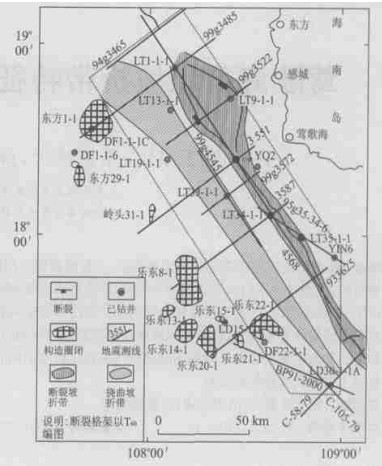
 下载:
下载:
